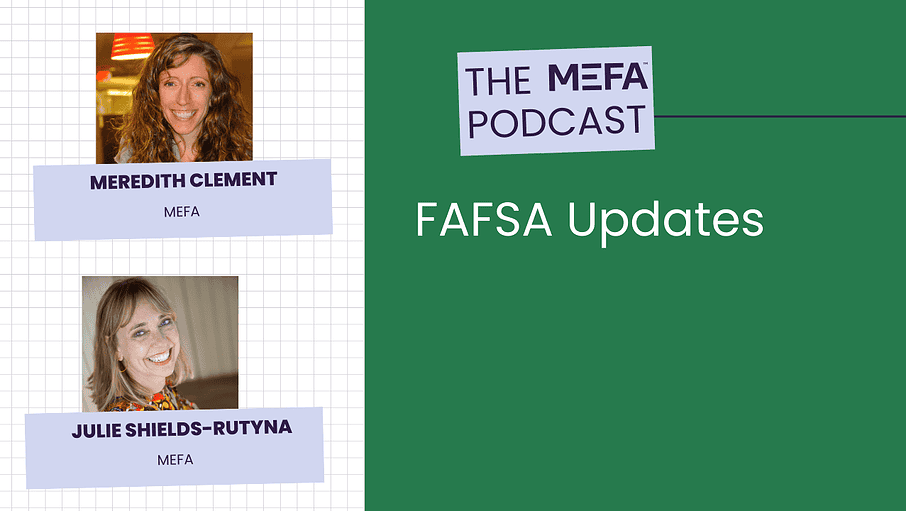

Resources Mentioned in this Episode
Please note that this transcript was auto-generated. We apologize for any minor errors in spelling or grammar.
Jonathan Hughes: Hi everyone. And welcome once again to the MEFA podcast. My name is Jonathan Hughes and with me, once again, is Julie Shields-Rutyna. So on the show today, we’re going to hear from officially MEFA’s Director of Integrated Marketing unofficially MEFA’s FAFSA guru. Newlywed Meredith Barnhart will join us.
She’s going to tell us about what’s new on the FAFSA this year, and we’ll of course, open up the MEFA mail bag and see what folks are asking about these days. But first, let me turn it over to Julie, who’s going to tell you what you should know this week. Come on, do it.
Julie Shields-Rutyna: Hello, happy to do that. I have a favorite story this week, and it’s about Worcester Polytechnic Institute, WPI, and that they eliminated their application fee to apply.
And that’s, so that’s a difference. Application fees can sometimes be expensive and it used to be $70 and it’s gone.
Jonathan Hughes: All right now. And why have they made that decision? Is this related to COVID or anything like that?
Julie Shields-Rutyna: I feel, you know, I feel like everything these days is related to COVID. Right?
Because we are all just taking another look, re-evaluating everything we do and how we do it. So in some ways, yes. But in general, I think it’s more, just a way to expand access, and take away any barriers or obstacles that might prevent students from applying to WPI and especially maybe, a more a diverse student body.
So it’s just to really open up that access equity. All of that. In fact, the Dean of Enrollment, Andrew Palumbo, he talks about it just as that requiring students to pay a fee, to receive an admissions decision really is in conflict with their mission. They want to really increase high quality STEM education for large numbers of students.
And so really they’ve been trying to put in a number of measures that will help that happen. For example, they became the first STEM university in the country to adopt this test optional policy. So students didn’t need to submit standardized test scores as part of their application. And I think this is another measure, you know, another step toward really, really opening up the admissions process.
Jonathan Hughes: That’s interesting. And that is something that we’ve seen a lot of colleges do during the pandemic, is suspending their requirements for standardized tests for admissions. So in that is, I think seen two ways, right?
There’s part of the reason for colleges doing that is because of the pandemic and that students really are having a much more difficult time actually taking the SATs®, and being in and finding scheduled SAT exams to take. But as he mentioned, you know, everything that’s having to do with COVID sort of, I think a lot of colleges have the question as to whether or not these colleges are going to keep this policy. Because it does sort of shine a light on some of the existing barriers, as you say that students do face.
Julie Shields-Rutyna: Yeah, I think that’s true.
I think there are issues, you know, with inclusion and there are equity discrepancies, and, the pandemic has only highlighted those. And so we have seen other colleges start, as you say, adopt those test optional policy, and we’ve seen even some tuition freeze, lots of things to hopefully make it easier to apply to college.
Jonathan Hughes: Well, thank you for bringing us that story. So now we turn once again to the mailbag where we have questions from parents and students that have come in throughout the past two weeks or so. Okay. So the first question comes from the parent of two seniors. So they have twins in college and they’re, well, they will have twins in college next year, and they’re both applying early decision.
And this parent is worried because her and her ex-husband, she has been divorced, and her ex-husband have not really gotten together to work out the taxes. Oh, I’m sorry. The college finances yet. So she’s never, she writes that they have 50/50 custody and she is worried that both will need to fill out the FAFSA and she’s nervous because perhaps she doesn’t know what her ex-husband has planned or has or has not done in terms of financial aid.
So she’s a little concerned about that. So, Julie, could you tell us a little bit about in the cases of divorce or separated parents, what happens and why should this person not really be too worried?
Julie Shields-Rutyna: Yes. Yes. So, well, it so happens in this case, her sons are applying to two institutions, UMass Amherst and St. Mike’s College, that required just the FAFSA for financial aid purposes. And so that’s always one tip. We tell students, you need to look and make sure you know what applications the colleges that you’re applying to require. So in this case, their favorite colleges just require the FAFSA. Now, when you file the FAFSA in a divorced parent situation, the people who file the FAFSA are the student with the parent that they lived with more in the last calendar year.
So I guess we don’t really know that from her question, but I guess maybe because she’s the one asking me, I can maybe be assuming that I’m not sure. But anyway, it would be the student and the custodial quote, unquote custodial parent, which is the parent of the student lived with most in the last calendar year.
Now sometimes families will say to us, well, you know, they’ve lived with us exactly the same and we give the exact same amount of money and all of that. And so then in that case, they just need to pick a parent to be the custodial parent. So I believe from what I have in this question, that the mother that would then be the custodial parent and she could file the FAFSA form with both boys.
And that is it, that would be the application for financial aid, which I think is a little bit good news for her. Because I always like to round out every question and answer. I’ll just add this for other folks. If other families are in this situation, but their kids are applying to a college that also requires the CSS Profile® form.
Well, in that case, the CSS Profile form does want that other spouse, that other ex-spouse to complete the form as well, and would be asked to complete a non-custodial profile form. So in that case, I would say it would just be have the family to get together to have that conversation and make that plan, because no matter what people are going to be obligated to, that doesn’t matter so much, but they do need to meet the requirements for applying for financial aid at the different colleges.
Jonathan Hughes: Yeah. And I’ll, I’ll round that out just a little bit further even, and to say, cause I think people sometimes have a follow-up with CSS profile that if you’re going to a college that requires that profile and they want the non-custodial parent file. If it’s a situation where there’s really no contact with that, parents with the non-custodial parents, then there are waivers that you can apply for and it’s up to the college whether or not you’ll be approved and granted that non-custodial profile waiver, but there is a process to deal with that issue.
And then I’ll just say, once again, this sort of reflects that the FAFSA is sort of a simpler form. And they, it’s a sort of a much easier answer sometimes than the profile. Now, heading on to question number two, the second question came in over the phone to me and I must confess, I don’t remember the name of the caller, but it is a very popular question.
And it’s where people filing the FAFSA or the profile and who have 529 plans or prepaid tuition plans. This particular person had both a U.Plan, which is the Massachusetts, the U.Plan Massachusetts prepaid tuition program and the U.Fund, which is the Massachusetts 529 plan. And he wanted to know both how you report the value of those on the FAFSA and then, you know, do you have to only do it for the child that you’re, filling out the FAFSA for, or do you have to do list the account totals for all of the children. Do you want to give an answer on that one, Julie?
Julie Shields-Rutyna: Oh, sure. Well, you know, the FAFSA asks for income information and also asks for asset information and the assets that go on the FAFSA are cash savings, checking investments, other real estate.
If someone had a vacation home, something like that. And so 529 plans or prepaid tuition plans really fall into the categories of savings and investments. And so for that reason, families need to report everything that they have, you know, that’s owned by the parent. So 529 plans are usually in the parent’s name, or the prepaid tuition plan in the parent’s name.
So they’re reported as parent assets and, you know, sometimes parents don’t like to hear that they need to report the assets that they have say saved for other siblings. But no one expects that you will take those out and use them. They know that those are for other siblings, but they’re just trying to get an overarching assessment of what assets you do have versus what some other families might have might have or not have.
And I’ll also add that parent assets are treated in a very lenient way on the FAFSA. They’re treated at a rate of 5.6%. So if a family has, let’s say $10,000 in assets, really that is only going to increase what they’re expected to pay for college per year by about $560. So yes, they’re counted, but they’re counting in a very small way.
Jonathan Hughes: Beautiful. Yes, that’s perfectly stated. So good news on that. And remember if you have any questions, please submit them to college [email protected]. You might be reading your question on the next episode where you can call us at 1-800-449-MEFA. And you can take advantage of any of the knowledge of any of our experts that are available to answer your questions.
So now it’s time to turn to our main topic of the day, which is of course the FAFSA. In October, it’s always the FAFSA and all the new changes for 2020. And to join us, as I said at the top of the show is MEFA’s Director of Integrated Marketing Meredith Barnhart. Hello, Meredith. How are you?
Meredith Clement: Hi. Good Jonathan. I’m great. How are you?
Jonathan Hughes: Okay, good. So just to let people know, can you tell us a little bit about FAFSA changes before we get into these specific changes? You know, why does the FASFA get changed, who changes it, and how often are these changes made and towards what?
Meredith Clement: Yeah, sure. So the FASFA administered by federal student aid. And that’s an arm of the department of education within the federal government. And every year they actually make FASFA changes. Some are significant. Sometimes they’re just small tweaks to language, and the purpose every year is to make the FAFSA as easy as possible for families to complete as well as the goal is to make sure that FAFSA collects the most accurate information from families.
So throughout the year, federal student aid is collecting feedback from school counselors, from students, from parents about completing the FAFSA. Things that they didn’t understand or were confusing. And then they go through a review process every year, decide what changes they’re going to make, and then they implement them for the next year.
Jonathan Hughes: Beautiful. Okay. So what changes are new this year then?
Meredith Clement: So there weren’t too many significant changes. One is the change to the income thresholds for what we call autos zero EFC. So when families fill out the FAFSA, they get what’s called an expected family contribution or an EFC, and it’s basically a calculated number and it’s supposed to represent what families can contribute towards college cost for one year.
There are certain families who were automatically given an ear zero EFC. So it’s assumed that they can’t contribute anything toward college costs. It doesn’t mean they’re going to get a full financial aid offer, but it means that it’s basically assumed by the colleges that they could give them all the financial aid for which they’re eligible because they can’t in theory, contribute anything toward college costs themselves.
So what changed with that understanding this year is that the income threshold changed from 26,000 to 27,000. So now families who make $27,000 or less, and they have to meet a few other criteria, but they meet that income threshold. They’ll be given automatically a zero EFC in that financial aid formula.
And the other criteria they have to meet. They either have to be a dislocated worker, which basically means they’re unemployed or underemployed. They have to maybe receive federal benefits or, and this is the third one, they have to have completed a pretty simple tax return and we can meet for that, but they meet one of those three criteria.
They’ve got income now 27,000 or less. They’ll get that zero expected family contribution number.
Jonathan Hughes: Wow. Okay. So that’s good to know. And you know, I don’t know if it’s something that is really just IRS data retrieval tool has some new updates to it as well. Do you want to talk about briefly what the IRS data retrieval tool is? And then what’s changed about it this year?
Meredith Clement: Sure. Yeah. So the IRS data retrieval tool is this fabulous tool that was implemented now a handful of years ago. And it allows families when they’re completing the FAFSA to automatically pull in their tax return data to answer the FAFSA questions. So anyone that’s completed a FAFSA knows that you get asked a lot of questions about your tax return.
What’s on line seven, what’s on line nine. With the IRS data retrieval tool, you really just click a button and the IRS pushes forth your tax return data, and it’s pulled into the FAFSA and automatically filled into the appropriate question. So families don’t really have to reference line seven or line nine.
They’re able just to answer those questions automatically by using that IRS data retrieval tool, it just pulls in that information. One thing that changed is on the fact that families are asking, did you file a schedule one? And that’s just the supplemental return to the main tax form, the 1040. Families are asked did you file a schedule one.
You would think there would be a simple yes or no question. They could look at their tax return and just see, do I have this form, a one. Unfortunately it’s a little bit complicated because families are told to answer no, even if they did file a schedule one, if they only filed a schedule one for certain reasons, then that includes unemployment of student loan interest deduction.
There’s about five or six reasons. Families were really tripped up by that question. They would look, they’d see they had a schedule one and they weren’t sure whether to put yes or no. They weren’t even sure of the reasons they didn’t understand them. Now, which is great news, the IRS data retrieval tool is going to answer that question automatically for families.
So they don’t have to answer it. The IRS data retrieval tool will comb their tax return, look at their schedule one, figure out the answer. Yes or no. And they’ll answer it for family. So really good news.
Jonathan Hughes: That does sound like really good news. It sounds very confusing when families, so we’re not into that. So that’s good.
And what else is there, if there’s anything else?
Meredith Clement: Yeah. So one of the things this isn’t really FASFA related so much, but it is related to federal student aid. There’s a great website. It’s student aid.gov and in the past, there’s been studentaid.gov that has a lot of information about federal financial aid, but then there were other federal student aid websites.
There were studentloans.gov. There were a couple other websites that housed information about students that are all financial aid and FSA realized this is too confusing with too many websites. So what they’ve been working hard to do is consolidate everything under studentaid.gov, which is greatly great news.
So student loans.gov, which is another big website, lot of people were familiar with that, went away. A couple of other smaller websites all went away. So now, if a family, typically a student is looking up information about their own federal financial aid, they can just go to student aid.gov. Yes. College administrators, high school counselors, if anyone else is looking for information about financial aid from the federal government, they all go to studentaid.gov
So good news. Just easier to remember and bookmark one website.
Jonathan Hughes: Yeah, it certainly seems to make sense. Then what are the things that we hear a lot about from parents and from students? Probably the most common thing in this process that we hear, that’s not related to the actual FASFA itself, but to the FSA IDs.
And these are IDs that parents and that students have to obtain before they can file their FASFA. So is there any changes to the FSA ID process?
Meredith Clement: Really the process is the same, but the verbiage is a little bit different. What we’re trying to do as an industry is instead of saying to someone, the FSA ID, which is a bit of a mouthful, we’re just really saying username and password. Because they have to say ID that’s really, all it is is students and parents select the username and then they select the password and that constitutes their FSA ID.
But when families hear FSA ID, sometimes they think it should be a number or an ID number assigned by the federal government. And instead it’s the username and password that they selected at the beginning of this whole FAFSA process. So what we’re all trying to say now is your FASFA username and password, we might say your FSA username and password, but we’re all trying to use that username and password language so that families understand, oh yes, it’s a username I selected, it’s a password we picked when I first filled out that FAFSA.
Jonathan Hughes: Okay. And is there anything else that’s changed?
Meredith Clement: Yeah, a couple of things. One is the public service loan forgiveness, and this is related to the FAFSA because once you fill out the FAFSA, if you get federal student loans, certain populations of people can qualify for loan forgiveness after you have worked for 10 years after college, and then paying back your loans. If you work for a certain employer, you can qualify for public service loan forgiveness, meaning that your loans are forgiven after 10 years. It’s a great deal. And a lot of the employers are nonprofits or government agencies.
In the past that’s been a little bit confusing for us. For really students, or I should say graduates of college, to understand if their employer was eligible or not. There are some stipulations. It’s not all nonprofits, not all government agencies. What federal student aid has done now is made a list of eligible players makes it much easier.
So even if you’re in college, you’re thinking about taking a job with an employer, or you’re thinking about switching jobs, you can now look up your list on that list to see if that employer is listed on there. And then you can know if your employer is indeed eligible for, or if you’re eligible for that public service loan forgiveness by working for that employer.
Jonathan Hughes: Oh, that sounds like a really, really good development. I know that the public service loan forgiveness has a lot of questions associated with it. And it’s something that, that graduates and folks who are wanting to pursue that at have had some difficulties sort of staying on track. So that seems like that’s going to help a lot.
Meredith Clement: Yeah, it’s a really positive change. And the other thing I’ll note, just in regards to federal student aid is when students take one of those federal loans, they are asked to sign a master promissory note. They actually have to sign it before they get their first loan their freshman year, or maybe they take their first one, their sophomore year, whenever they first begin borrowing from the federal government for college.
And the master promissory note is basically something that students can sign electronically just as they’re agreeing to take the loan and to pay it back in the past. Students only had to sign that once and then they could take four years or five years of these federal student loans. And based on a lot of feedback from parents, from college administrators, from students themselves, there’s been a change.
Now there’s something called the annual student loan acknowledgement. And this is an acknowledgement form that students are now going to have to sign every year starting with this upcoming academic year, that’s 2021-2022 academic year. And it means that every year when students want to borrow a federal student loan, they’ll have to sign this acknowledgement and the acknowledgement will state how much they’ve borrowed so far in federal student loans.
And it’s to help students understand that if they are borrowing loans every year, obviously that’s going to accumulate into it can be a significant amount. And so every year students need to see, okay, I filed 5,500. Okay. Now I’ve borrowed 10,000. Okay. Now I’ve borrowed 14,000 and they just have to acknowledge that they’ve seen that number.
They understand. And again, they’re borrowing a loan that they will repay after graduation.
Jonathan Hughes: That sounds that’s again, all of these changes seem very sort of common sense, intuitive changes. Right? Exactly. So let’s hope that they really do help in the long run. And I know that, you know, the project for the FAFSA is always to simplify and always to help families and the students really understand the process and to make it as easy as possible to complete. But also to understand, and to, you know, make there aid process and the borrowing process as simple as possible and understandable as possible. So that was what we have for updates for 2020, 2021. Meredith, you don’t know this, but earlier in the episode I referred to you as newlywed Meredith Barnhart. So yeah, being newly wed, and we hope to have you back again soon.
It was, it was a pleasure. And remember, if anyone has any questions regarding federal aid, please visit studentaid.gov.
Meredith Clement: Thank you. Thank you so much for having me.
Jonathan Hughes: Thanks for being on. Thanks.













